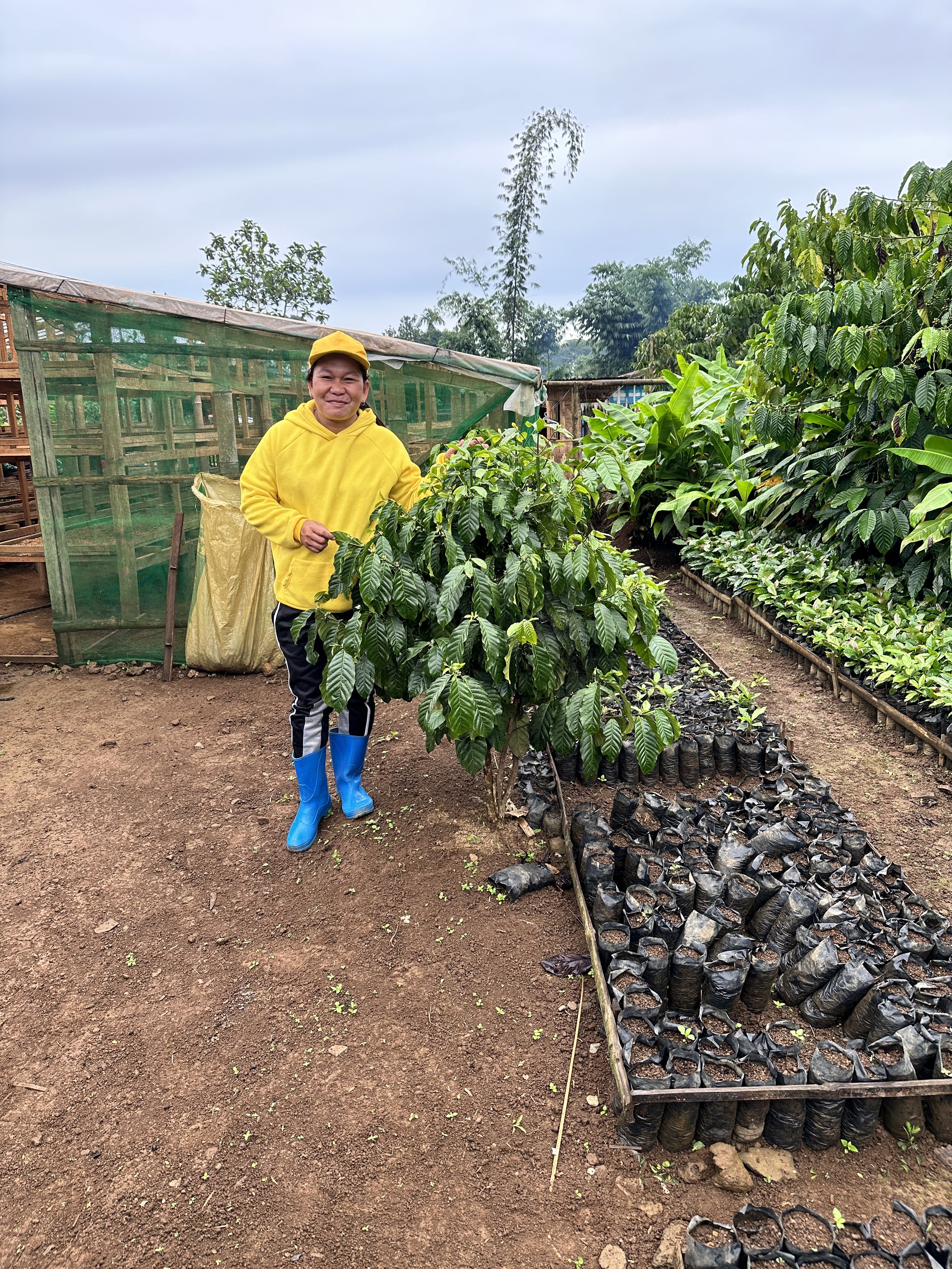Majestic Mountains and Rolling Hills in the Philippines: Visiting Kalsada Coffee
For many years, the Philippines hasn’t been particularly known for growing coffee–and if it was, most folks would dismiss it as a country that produces low quality beans, or the heavy and robust barako (liberica variety). But over the last five or so years, we’ve started to see Philippine coffee proudly served in specialty cafes, thanks to the work and commitment of Kalsada Coffee Company.
Kalsada Coffee Company is a social enterprise that was started in 2014. The heart of their operations is working in partnership with farmers and the communities they operate in. They’ve built trust over the years by actively spending time in the communities to learn about farmers' challenges, needs, and consulting with them on future plans.
In general, most farmers that Kalsada works with primarily grow vegetables and have coffee as a secondary crop. They learned how to cultivate coffee from their forefathers, and there were no set standards for producing coffee. As a result, quality was inconsistent and coffees were sold at low prices to the local market. Kalasda has been able to help farmers in a few ways: they shared tools and resources that have allowed farmers to better manage their crops, and they built centralized community mills so that farmers didn’t have to process their own coffees. This way, farmers could focus on growing sweeter coffees and Kalsada could standardize post-harvest procedures that could improve overall coffee quality. While there are still farmers who process their own coffee, many choose to send their meticulously harvested cherries to the mill because they gain higher prices for cherries and also don’t have to do the extra work of processing their own coffee. That said, farmers have the option earn even more income by helping with mill operations, sorting coffees and preparing then for export.
Andytown has been working with Kalsada coffee for several years now, and I was excited to finally have the opportunity to visit and see their operations earlier this year. This was the first origin trip for US roasters that Kalsada was able to organize since before the pandemic, and everyone who came along had been eagerly waiting for the last few years. There was Ria from Four Letter Word in Chicago, Mo and Rikki from Kindness in Mischief in Los Angeles, Paul and Kristine from Out of Office Roasters in Long Beach, and myself. This trip was led by Tere Domine, Co-Founder and Country Director of Kalsada, and Sam Tagam, Kalsada’s Field Officer. We were also joined by Kalsada Coffee’s founder, Carmel Laurino.
Our trip to the mills and farms were broken into two parts: we spent several days up north in Benguet, and then flew to Bukidnon in the south.
Benguet: Sitio Belis, Sitio Naguey, and Sitio Kisbong
While Benguet Province isn’t necessarily far from Manila, the trek there can double in time if we hit traffic–both within metro Manila and also while going up the windy roads in the Cordillera Mountain Range. The higher up we went, the more we were surrounded by towering peaks. Kalsada’s mills are located in the small district (barangay) of Caliking in the Atok Municipality.
Walk with me to Belis! We start on the road that connects the sitios on the hillside. From there, we go down the path to the center of Belis, and then go farther down to get to the mill and Auntie Asthrine’s home. Although not filmed, beyond the drying beds is Auntie’s coffee farm—and other farmers who live down the hillshide.
The road to Belis is small and rugged; it stems from the main paved road and down the hillside. Before heading down, we needed to hop onto a more powerful vehicle that can handle the terrain, so we left our van and moved all of our belongings into a jeepney–an iconic public transportation vehicle used in Philippines. From there, it was a slow, 10 minute bumpy but scenic ride to another road that connects the several sitios (small, rural neighborhoods) down the hillside, and then another small road that took us down to Sitio Belis.
Asthrine Pias (who we all addressed as Auntie) and her family graciously hosted us in their home during our stay. Auntie Asthrine is the manager of the Sitio Belis mill, which was built right next to their home. Harvest had just about wrapped up when we arrived; there were few cherries remaining on trees, few coffees left on the drying beds, and most were already placed in storage to rest before it was time to sort and prepare for export. Belis mainly focuses on washed coffees, but occasionally does some small experiments as a way to understand the potential of their coffee and learn more about the results post-harvest processing.
While Belis produces the most coffee from all of Kalsada’s Benguet mills, it may not ever reach its full potential: Many farmers throughout Benguet have land that stretches far into the steep hillside where coffee trees essentially grow wild. Farmers usually ignore those trees since they’re difficult to access, and it would be too costly to try and restructure the land.
On the other side of the hill and less than a mile away is Sitio Naguey. It’s not common practice to build mills so close together, but the terrain is rough, and it’s impossible to get in and out of Naguey without slowing your stride and increasing your heart rate! In the early days when Kalsada was still learning about the community, farmers in Naguey told Kalsada that the challenge to get to Belis would discourage farmers from bringing their cherries there. So, Kalsada built a mill in Naguey. Up until the last few years, all coffees had to be brought up by foot–about a 30-40 minute hike when carrying coffee. Now the dirt roads–which were built by hand–are more defined and it’s easier for a truck to come down and haul coffee.
The Naguey mill is small but mighty, and is managed by Cynthia Bayating. When the mill first began its operations, there were only 10 contributing farmers. That number continues to grow, with now 30 farmers adding their coffees to the community lot. There’s a preference for producing natural processed coffee in Naguey because it’s sunnier there. But when the rainy season lasts longer and it seems that the harvest season will mostly be wet, Naguey switches to producing washed coffee to ensure quality.
About an hour’s drive away and on the other side of Caliking is Sitio Kisbong. This is the largest coffee growing area in Caliking, and because the community is also much larger, farmers have more access to green coffee buyers. Although Kalsada has focused on working with farmers in more remote areas, they eventually built a mill in Kisbong since farmers would travel all the way to Belis to sell their cherries.There are over 30 farmers who contribute to the Kisbong mill, and while we weren’t able to meet with Burton Garcia, the Kisbong mill manager, we we able to meet with a small handful of some of the farmers who contributed to Kisbong for the 2023 harvest season.
Bukidon: Sitio San Roque
Kalasda’s fourth mill, Sitio San Roque, is in the Pigtauranan barangay, Bukidnon province. It’s at the foothill of the Kalatungan mountain range, but hard to tell you’re at elevation here; unlike north with its majestic mountains, we drive and walk through rows of rolling hills. The flatter ground makes it easier to set up a farm with neat rows of coffee trees. Because of terrain, the majority of Philippine coffee is produced in the South.
Kalsada was introduced to a cooperative of coffee farmers in Pigtauranan in 2016. At the time, most cultivated robusta and arabica, in which the latter had little attention since robusta dominated the commodity market. After helping process coffees in the region and tasting its potential, Kalsada decided to build the San Roque mill in 2020. It’s managed by Eralyn Libante, who is one the first farmers of San Roque to work with Kalsada.
In the last few years, Kalsada also purchased 11 acres of land and has started to grow their own coffee. This was never a part of the original plan–Kalasda’s main goal was to help farmers improve the quality of their coffees and help them gain the specialty market, not become farmers themselves. But after several farmers approached the Kalsada team, asking them to buy their land because they couldn’t pay off their high interest loans and had a hard time feeding their families, Kalsada couldn’t say no. So, they purchased the land and decided to build a farm with the intention of having it serve as a model farm for other coffee growers who are looking to improve their operations. The farm is managed by Eralyn’s husband, Arnold. Other farmers of San Roque have helped cultivate the land and plant coffee trees, and in perhaps another 3 years, they will start to bear fruit and have their first harvest.
Final Thoughts
My own personal connections to the Philippines made this trip a very special experience for me. In a lot of ways, it felt like a homecoming. Spending time in the communities, sharing meals, drinking coffee together, singing karaoke, playing games during community gatherings–I felt very much at home and as if I was spending time with my own family.
When it came down to selecting which Kalsada coffee to feature this year, we decided to lean back on Sitio Belis–the first coffee we ever purchased, and the community in which we spent the most time in. This coffee reminds us of citrus fruits, muscovado sugar, and latik (toasted coconut milk curds used as a topping in Filipino desserts). Not too bright, not too heavy, but having just the right balance between acidity, sweetness, and smooth body. This coffee is for people on opposite sides of the spectrum: whether you like your coffee black, or dressed with milk and sugar, it’s one that both younger and older generations can enjoy.
















